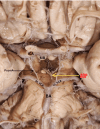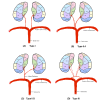Artery of Percheron, an Uncommon Variant of Posterior Cerebral Circulation: A Case Report
- PMID: 38686254
- PMCID: PMC11057671
- DOI: 10.7759/cureus.57266
Artery of Percheron, an Uncommon Variant of Posterior Cerebral Circulation: A Case Report
Abstract
The posterior communicating artery (PcomA), P1 and P2 segments of the posterior cerebral arteries (PCAs) give rise to numerous small branches that chiefly supply the thalamus and midbrain. Thalamic vascular supply is classically categorized into four regions: anterior, paramedian, infero-lateral and posterior. Despite significant variations and overlap in the blood supply, this traditional classification helps in understanding the vascular anatomy of the thalamus. Gerard Percheron extensively studied thalamic blood supply and described its anatomical variants depending on its origin. The artery of Percheron (AOP) is a rare anatomical variation of paramedian-mesencephalic arterial supply in which a solitary arterial trunk arises from the PCA and distributes bilaterally to both paramedian thalami and often to the rostral part of the midbrain. During routine dissection of the brain of a 46-year-old female in the department of anatomy, it was seen that thalamo-perforating artery (AOP) took origin as a single trunk from the P1 segment of the left PCA. The specimen was dissected and photographed for documentation and to see more details. The exact prevalence of AOP remains unknown, but various studies show that it can be present in 7% to 11.7% of subjects. Detailed knowledge of AOP anatomical variation is crucial for interpreting neuroimaging results or performing different neuro-endovascular techniques at the basilar bifurcation, particularly in patients with bilateral thalamic and midbrain infarctions.
Keywords: artery of percheron; neuroimaging; posterior cerebral artery; thalamoperforators; thalamus.
Copyright © 2024, Ratanpara et al.
Conflict of interest statement
The authors have declared that no competing interests exist.
Figures


Similar articles
-
Posterior Cerebral Artery Stroke.2023 Aug 8. In: StatPearls [Internet]. Treasure Island (FL): StatPearls Publishing; 2025 Jan–. 2023 Aug 8. In: StatPearls [Internet]. Treasure Island (FL): StatPearls Publishing; 2025 Jan–. PMID: 30335329 Free Books & Documents.
-
Artery of Percheron infarction a rare anatomical variant and a diagnostic challenge: Case report.Radiol Case Rep. 2020 Oct 28;16(1):22-29. doi: 10.1016/j.radcr.2020.10.032. eCollection 2021 Jan. Radiol Case Rep. 2020. PMID: 33163128 Free PMC article.
-
Artery of Percheron Infarction: A Characteristic Pattern of Ischemia and Variable Clinical Presentation: A Literature Review.Curr Med Imaging. 2021;17(5):669-674. doi: 10.2174/1573405616666201130095801. Curr Med Imaging. 2021. PMID: 33256583 Review.
-
Bilateral thalamic stroke due to occlusion of the artery of Percheron in a patient with a patent foramen ovale.J Nat Sci Biol Med. 2016 Jan-Jun;7(1):109-12. doi: 10.4103/0976-9668.175108. J Nat Sci Biol Med. 2016. PMID: 27003984 Free PMC article.
-
Imaging the artery of Percheron: a pictorial review of associated pathology with important mimics of bithalamic abnormalities.Neuroradiology. 2025 Apr;67(4):785-798. doi: 10.1007/s00234-025-03585-2. Epub 2025 Mar 10. Neuroradiology. 2025. PMID: 40063261 Review.
Cited by
-
Type III Percheron's variant in thalamic-mesencephalic infarction: the unexpected anastomosis.Surg Radiol Anat. 2024 Nov;46(11):1769-1774. doi: 10.1007/s00276-024-03472-0. Epub 2024 Sep 3. Surg Radiol Anat. 2024. PMID: 39225864
References
Publication types
LinkOut - more resources
Full Text Sources
